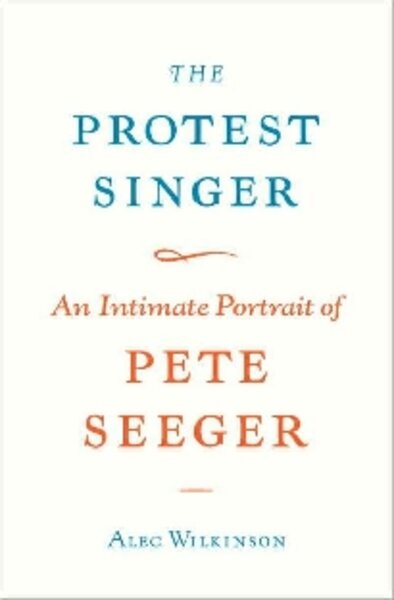The Protest Singer
Loading...
Alec Wilkinson has written a short volume about a slim fellow who has lived a gigantic life. Pete Seeger is one of those iconic American names – like Johnny Appleseed or Paul Bunyan – that evokes more legend than man. Does he really exist? How many among you have ever heard him perform? How many own any of his records or CDs? I see very few hands raised – including my own.
Pete Seeger is, indeed, an actual human, now 90 years old and still going strong. (Heck, he won a Grammy just a few months ago.) And he is well worth knowing – but more because of what he’s sung and where and when he’s sung it than for what his music sounds like. He’s also remarkable for the green life he’s lived (long before it was cool) and for the countless people he’s inspired to action through songs and example.
The Protest Singer is the intimate portrait of the man who sparked the folk boom of the 1950s, marched with the Rev. Martin Luther King in Selma, stood up to McCarthy-era blacklisting and the Ku Klux Klan, and spent 40 years cleaning up the Hudson River. He’s a strong but shy man who built his first home with his bare hands from trees he felled himself. Material possessions have never interested him in the slightest. Seeger never aspired to a career as a singer and has no taste for fame.
“I seem to stagger around this agonized world like a clown, dressed in happiness, hoping to reach the hearts and minds of the young,” he once wrote in a journal. “When reporters ask me what effects my songs have, I try and make a brave reply, but I am really not so certain.”
From an early age, Pete Seeger has fervently believed in the power of folk songs to unite people in a common cause. His simple, stirring anthems “I Had a Hammer,” “Turn, Turn, Turn,” and “Waist Deep in the Big Muddy,” have emboldened scores of activists to stand up to power, fortified by the message of song.
Seeger is so uncomfortable with being an entertainer that he sometimes urges his fans not to buy his records; he prefers they sing the songs themselves. And sing them they have – at Selma, Ala., and the 1968 Poor People’s March on Washington. He’s encouraged activists to sing for workers’ rights and at voter registration drives. He’s sung his songs to protest war and segregation, and to fight for nuclear disarmament and the environment.
And he led more than a million fellow celebrants in song at President Obama’s recent inauguration.
Wilkinson has been a contributor to The New Yorker since 1980. When he approached the singer about writing his story, Seeger requested that it be brief enough to be read at one sitting. The result is a quick read that is both pithy and entertaining.
“The Protest Singer” begins with Seeger’s nonconformist upbringing by classically trained musicians with populist ideas. “My father was socialized when another professor took him to the lettuce fields ... and he saw children the same age as me and my brothers being worked to the bone,” Seeger recalled. Later, during the run-up to World War I, Seeger’s father publicly declared himself a pacifist, a most unpopular stand to take in those days.
Seeger would later endure the same sort of threats and hatred for his own association with political outcasts like Woody Guthrie and Paul Robeson, and for his support of unpopular causes. His brief association with the Communist Party in the 1940s (which he strongly disavowed upon learning of Stalin’s brutality) and a lifelong antiwar stance have made Seeger a pariah to many. But he soldiers on and even his harshest critics must concede that he’s the epitome of a man who walks the walk.
When Seeger was just a toddler, his parents embarked on a cross-country concert tour on a flatbed truck, hoping to share their passion for classical music with “the people.” The vagabond family drew gawkers, most of whom were less than thrilled by the music. But a seed was planted within Seeger. Eighty-eight years later, he is still awestruck by music’s power. “When you sing,” he says, “you feel a kind of strength; you think, I’m not alone, there’s a whole batch of us who feel this way.”
As a teenager, Seeger heard folk music for the first time when his father worked with Alan Lomax, the renowned musicologist whose field recordings from the South reintroduced authentic “folk” music to America. “Compared to the trivialities of the popular songs my brothers and I formerly harmonized, the words of these songs had all the meat of human life in them,” said Seeger. As an eager young man he, too, worked for Lomax, and in the process fell – hook, line, and banjo – for folk music.
If there were a Mount Rushmore of folk music, Seeger would be carved in stone. Yet here he still is, happily married to the same woman for 56 years, living on the same 15 acres of land he purchased a half century ago, sailing on his beloved Hudson River, singing his folk songs and bringing people together. Seeger’s life has been – and continues to be – a uniquely American anthem.
John Kehe is the Monitor’s design director.






